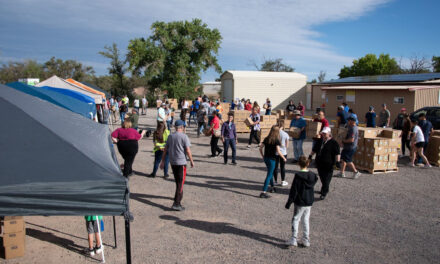Staff shortages are leading to fewer ambulances in Valencia County, leaving local fire departments to fill in the gaps.
“The fire department has a statutory requirement for fire protection,” said Valencia County Fire Chief Matt Propp. “We do EMS because it’s the right thing to do for the community, but it’s our legal obligation to have units for fire protection.
“When we’re transporting to a hospital in Albuquerque, those are our firefighters and that puts fire protection at risk.”
At a recent Valencia County Commission meeting, Propp told commissioners the number of AMR ambulances throughout the county has been decreasing. In the last month, the chief said the ambulance company has reduced its overnight units in the county to two for coverage throughout the unincorporated county and five municipalities.
In a phone interview after the Sept. 6 commission meeting, Propp said his concerns and frustrations with the ambulance service are shared by AMR.
“At the local level, the AMR supervisors have been really good. They understand the problem and they’re frustrated, too,” the chief said. “I’m not bashing them but as the county fire chief, it’s my responsibility to make sure we have enough ambulances for EMS but also enough staff to run fire calls when they occur. This is not shot at AMR. We’re all facing the same problem, which is staffing.”
Propp told the commission AMR personnel indicated to him staff issues were the primary reason behind the lower number of ambulance units in the county.
“With two, as you can imagine with the call volume the county has, those last about 45 minutes then we have no units,” he said. “Fire units have been transporting quite a bit lately. We would like to add two more ambulances to the fleet so we have the accessibility and ability to transport.
“I anticipate the situation is going to stay the same or get worse. This will let us stay ahead and stay sustainable.”
Ruby Boyd, the operations supervisor for AMR ambulance service’s Valencia County operations did not respond to News-Bulletin requests for comment on the issue.
The scenario where AMR units are tied up on other calls or are already at Albuquerque hospitals waiting to hand over patients, leaving county and municipal units in the position of having to transport is commonly referred to as Status Zero. The News-Bulletin reported on the Status Zero situation in Valencia County in June.
Dr. Whitney Barrett, the medical director for EMS services in Valencia County, says Status Zero is an issue that affects everybody and is one of the biggest challenges agencies are currently trying to navigate.
Barrett, who’s also an emergency medicine doctor at the University of New Mexico Hospital in Albuquerque, said a variety of factors including population growth, a population with more complex medical issues and a shortage of EMS staff can lead to Status Zero.
“Whatever ambulances they have that are designated to the county are either on another call or transporting somebody to hospital. The ripple effect is sometimes when a call comes in to dispatch and we don’t have the usual resources to send,” Barrett told the News-Bulletin in June. “We get people to the scene to stabilize the patient, but then we are kind of stuck on how to get them to the hospital.”
Valencia County Commissioner Joseph Bizzell asked if other municipalities were willing to help cover gaps in transport services. Propp said he and the fire chiefs around the county meet regularly to discuss the problem and coordinate solutions.
“There have been times when Belen is coming into the county and we’re going into Belen and Rio Communities. Los Lunas is crossing (jurisdictional) lines,” he said. “It’s not just us providing support. If resources are available, they’ll help but it’s a domino effect. Responses are crossing jurisdictional boundaries all the time. It’s the only way to stay sustainable.
“We also have to stay cognizant of our obligations. If Belen is needing help and we’re busy, our obligation is to serve the county.”
Hearkening back to more than a decade ago, Commissioner Jhonathan Aragon asked if it was possible to have municipal and county units meet AMR ambulances in the county somewhere and “hand off” the patient for transport to Albuquerque.
“I know we’ve seen that done in the past. The biggest reason we have long wait times is the admitting times at the ER,” Aragon said. “Could we do that to keep units in Valencia County?”
Propp said AMR units are sitting at the hospital as well.
“We’re working with our medical director to create a policy for drop off at a hospital,” the chief said. “If the patient is not critical, after 15 minutes, we give the run sheet to admitting and clear the unit. If the patient is not stable that all goes out the window, obviously. We transport a lot of very sick people out of the county and get stuck an hour or two waiting for a bed. This new policy direction is going to help cut down on that a bit.”
The patient “hand off” scenario referenced by Aragon was fairly common when there was only one ambulance service — Living Cross — operating in Valencia County. County and municipal ambulances would stage at a location, the Los Lunas Interstate 25 interchange, for instance, to wait for a LCAS unit to return from Albuquerque, then transfer the patient to the ambulance unit and then the crew would the run back up to Albuquerque.
AMR was issued a permanent certificate of transport in Valencia County in September 2013, and operated alongside Living Cross until early 2017 when LCAS announced it had notified the state Public Regulation Commission, which issues transport certificates to ambulance services, it was ceasing operations “until further notice.”
The company had a year to do something with its certificate before the PRC considered it abandoned. LCAS did not resume service.
Propp said county and municipal ambulance units have a “certificate of necessity,” which allows transport if a patient is critically ill or injured and there are no ambulances available.
Obtaining a certificate of transport from the PRC is something Propp described as a “last case scenario. If AMR can provide enough units and we can come to an agreement so we’re getting adequate response, the best case is to let that continue to happen.”
Julia M. Dendinger began working at the VCNB in 2006. She covers Valencia County government, Belen Consolidated Schools and the village of Bosque Farms. She is a member of the Society of Professional Journalists Rio Grande chapter’s board of directors.


















